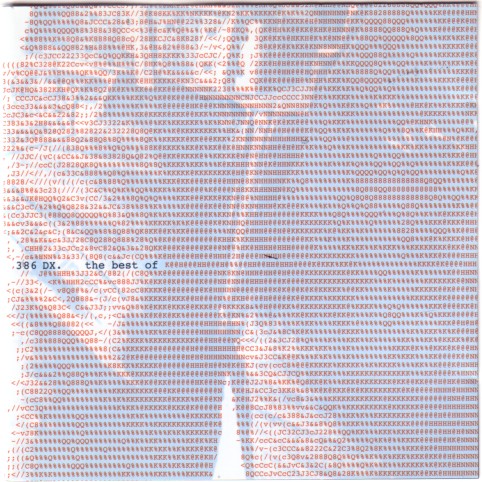ASCII art
Tuesday, 29 April 2008
I am fascinated with codes. I have little talent for mathematics, so my understanding for codes is limited. But books and movies like PI, Matrix, What-is-the-title-of-that-book-by-Stephenson?, etcetera are easy enough to understand for people like me. (Still, I do hope to wake up one morning with a new brain, that does understand mathematics at a deep level!)
A few years ago I spend a lot of time thinking about the story of Jan Sloot. It is more than a story, it really happened, about eight years ago, in Holland. Although it is unclear what exactly happened. You can easily find the information on the Internet, but I will tell you my version of this story.
I was writing a series of columns about Life’s greatest mysteries, in which I set myself the task to give my best shot for the solutions. It was written as a joke, but I took it very serious. Having read many books on these subjects and spending many many hours thinking about it, I really did my best to come up with the best ideas my mind could produce on mysteries as Atlantis, aliens, angels, 2012, The Hall of Records, etcetera. While working on these columns, I got a minidisk from Ruud Hulleman, with on it a recording of a television news item, which he thought I would like to hear. It was about a Dutch inventor, who claimed to have found a method to store almost infinite amounts of data on one single microchip. The name of the man was Jan Sloot. After years of trying to sell his invention, he had teamed up with Roel Pieper, and they managed to get the biggest deal ever made in Silicon Valley. I think they got a contract of 5 billion dollars. But the night before Jan Sloot was to sign the contract, and to give the secret of his invention, he died from an heart attack. The secret was nowhere to be found, and what left is a mystery, with many people telling nonsense and lies about it.
Jan Sloot had said that his method was so utterly simple, that he would not tell anybody anything, because then they would immediately understand how it worked. So he kept it all secret. But he gave several demonstrations, and although not everybody was convinced that the invention was genuine, many were. Enough to get that five billion dollar contract. After his dead, many people have searched for the secret, but as is said, nothing has been found so far.
I knew little to nothing about data compression, but if Jan Sloot’s method was indeed as simple as he said, I must be able to find the solution myself. It would be a nice column anyway, so I spend a few days thinking about it. After I had written the column, I showed it to a friend, who worked in the IT-business. He said that there were some very unusual but interesting aspects to my punk approach to data compression, and he said that I should work it out in more detail. That took me another few weeks, an by then I had already crossed the threshold that separates ordinary reality and the dream world of the insane.
To cut a long story short, I published my ideas in two zines, which, to my surprise, were well received by the few people that read them. But nowadays I no longer believe what I believed when I wrote them. I still think that there are some interesting aspects to it, but I don’t have the brains for this kind of puzzles.
It is also still completely unclear to me if Jan Sloot was a cheater or an idiot, or if he had really found a method to compress incredible amounts of data ( 64 full length movies without data reduction at demonstrations!) into one microchip. There is a book written about all this by Eric Smit, and there seems to be a movie in the making after this book, but I don’t expect that the mystery will ever be solved in the movie.
While thinking 24 hours per day about data compression, data reduction, algorithms, codes and related subjects, I stumbled upon many ideas and insights that are worth mentioning. I was reminded of all this when Arjen, my webmaster, asked me if I had ever seen ASCII art. No, I had not. So he explained me how it worked, send me a link and sucked me into a world that I find hard to resist:
.
There are many ASCII versions of movie scenes, and I read about scenes from The Matrix too, but all I could find on YouTube is this intro:
.
You can do your own search for more of this material, but here is one more video that I liked very much. The title is important here: I’m in the Matrix:
.
And, if you have nothing better to do, watch the video’s on this site!
.
This story is a nice excuse to pick a CD from my shelves that I loved to listen to for a while, but that I haven’t touched in years. The title of the CD is The best of 386 DX. Here is Imagine:
.

Comments:
Kimmie
2008-05-03 05:05:00
“Cryptonomicon” is the Stephenson code-breaker novel
Eric Gaston
2008-05-07 02:29:19
Ik heb die ascii Matrix DVD ergens liggen.. zal eens zoeken dan kunnen we misschien iets regelen
Arjen
2008-04-29 14:02:52
There is also Deep ASCII an ascii version of the 70’s porn movie Deep Throat which was made by the ASCII Art Ensemble